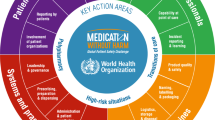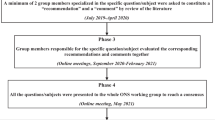Abstract
Background/objectives:
The use of drugs via feeding tube is problematic. Appropriate techniques must be used during the administration to prevent obstruction of a feeding tube, to avoid inadequate drug effects and to minimize the risk of toxicity of the given pharmaceuticals.
Subjects/methods:
In this study, medications of all the patients in a University Hospital with 1100 beds were monitored to identify the appropriateness of administration. The study was performed on 5 days each in 5 consecutive weeks to observe the current practice. After evaluation of practice, a questionnaire was given to doctors, nurses and pharmacists to determine the health-care professionals’ attitudes on drug administration through a feeding tube.
Results:
A total of 225 drugs (out of 13 935) were administered via feeding tube during the study period and 40.5% (n=91) were not administered in appropriate dosage forms. Only 86% of the doctors and 98% of the nurses stated that they pay attention to the suitability of drugs when they prescribe or administer drugs via feeding tube. Only 58% of pharmacists, 17% of nurses and 24% of doctors were aware of the fact that enteric-coated tablets should not be crushed owing to the risk of tube occlusion and lack of efficacy when they are administered via feeding tube.
Conclusions:
This study demonstrated the discordance between the theoretical knowledge and the practical performance of the health-care professionals in drug administration. In patients with feeding tubes, assessment of drug dosage forms by a pharmacist would be beneficial for appropriate administration and to prevent drug interactions.
This is a preview of subscription content, access via your institution
Access options
Subscribe to this journal
Receive 12 print issues and online access
$259.00 per year
only $21.58 per issue
Buy this article
- Purchase on Springer Link
- Instant access to full article PDF
Prices may be subject to local taxes which are calculated during checkout
Similar content being viewed by others
References
Magnuson BL, Clifford TM, Hoskins LA, Bernard AC . Enteral nutrition and drug administration, interactions, and complications. Nutr Clin Pract 2005; 20: 618–624.
Beckwith MC, Feddema SS, Barton RG, Graves C . A guide to drug therapy in patients with enteral feeding tubes: dosage form selection and administration methods. Hosp Pharm 2004; 39: 225–237.
Schier JG, Howland MA, Hoffman RS, Nelson LS . Fatality from administration of labetalol and crushed extended-release nifedipine. Ann Pharmacother 2003; 37: 1420–1423.
Bankhead R, Boullata J, Brantley S, Corkins M, Guenter P, Krenitsky J et al. Enteral nutrition practice recommendations. JPEN J Parenter Enteral Nutr 2009; 33: 122–167.
Seifert CF, Johnston BA . A nationwide survey of long-term care facilities to determine the characteristics of medication administration through enteral feeding catheters. Nutr Clin Pract 2005; 20: 354–362.
Madigan SM, Courtney DE, Macauley D . The solution was the problem. Clin Nutr 2002; 21: 531–532.
Ekincioğlu-Bayraktar A, Demirkan K . Clinical nutrition and drug interactions. Ulus Cerrahi Derg 2013; 29: 177–186.
de Amuriza Chicharro N, Romero Jimenez RM, Valero Zanuy MA, Gomis Munoz P, Herreros de Tejada A . [Evaluation of drug administration through enteral feeding tubes in hospitalized patients]. Nutr Hosp 2012; 27: 879–888.
Guenter P, Boullata J . Nursing2013 survey results: drug administration by enteral feeding tube. Nursing 2013; 43: 26–33.
Dashti-Khavidaki S, Badri S, Eftekharzadeh SZ, Keshtkar A, Khalili H . The role of clinical pharmacist to improve medication administration through enteral feeding tubes by nurses. Int J Clin Pharm 2012; 34: 757–764.
Acknowledgements
We thank all doctors, pharmacists and nurses for their kind support to participate in this survey.
Author information
Authors and Affiliations
Corresponding author
Ethics declarations
Competing interests
The authors declare no conflict of interest.
Rights and permissions
About this article
Cite this article
Demirkan, K., Bayraktar-Ekincioglu, A., Gulhan-Halil, M. et al. Assessment of drug administration via feeding tube and the knowledge of health-care professionals in a university hospital. Eur J Clin Nutr 71, 164–168 (2017). https://doi.org/10.1038/ejcn.2016.147
Received:
Revised:
Accepted:
Published:
Issue Date:
DOI: https://doi.org/10.1038/ejcn.2016.147
This article is cited by
-
Medication delivery errors in outpatients with percutaneous endoscopic gastrostomy: effect on tube feeding replacement
Scientific Reports (2023)
-
A Safe Way to Administer Drugs Through a Nutrition Tube—The Simple Suspension Method
Dysphagia (2022)
-
Reduce medication errors in tube feeding administration by establishing administration standards and standardizing operation procedures
Drugs & Therapy Perspectives (2020)



